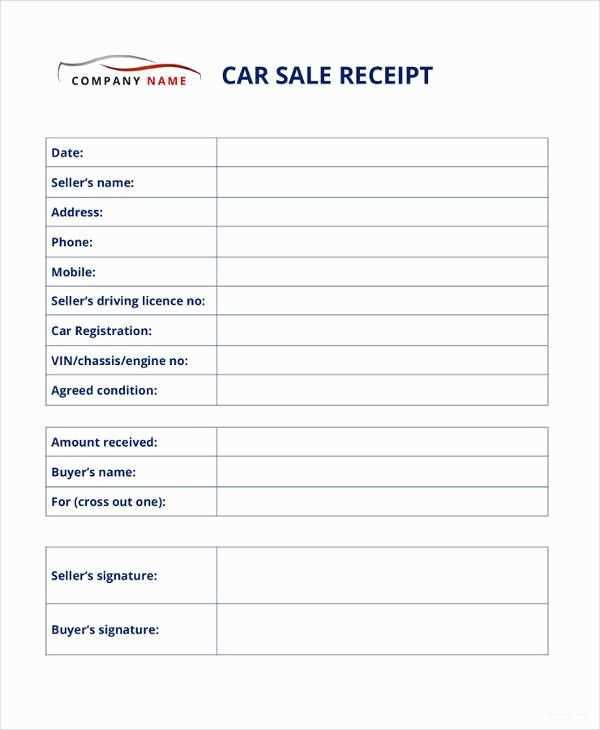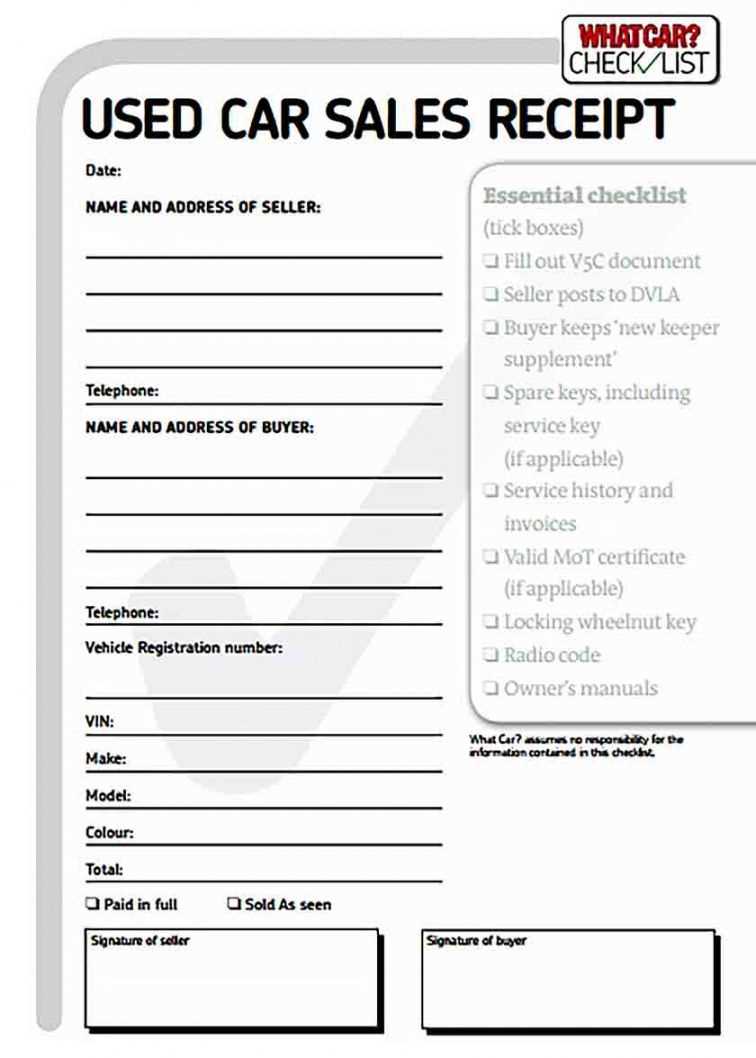
If you’re selling a car in Australia, having a clear and simple receipt for the transaction is key. A car sale receipt protects both the buyer and the seller by providing proof of the transaction. This template will help you outline the necessary details for a smooth sale, ensuring that both parties understand their rights and responsibilities.
The receipt should include the seller’s and buyer’s information, such as full names, addresses, and contact details. You’ll also need to specify the vehicle details, including make, model, year of manufacture, and Vehicle Identification Number (VIN). Don’t forget to add the sale price and the date of sale to make it official. This way, there is no ambiguity about the terms of the sale.
Another important element is noting whether the car is sold as-is or with a warranty. In most cases, cars are sold as-is, meaning the buyer accepts the car in its current condition. If a warranty is included, make sure to clearly state the coverage period and any terms involved.
By using this simple template, you can ensure that both parties are protected and that the sale is properly documented. Avoid potential disputes or confusion later by having a formal, written agreement with all the necessary details in place.
Here is the corrected version:
When creating a car sale receipt in Australia, ensure that all necessary information is included for both the seller and buyer to keep proper records. The document should clearly state the details of the transaction and specify the car’s condition and any warranties, if applicable. Here’s a template you can follow:
Required Information
- Date of sale: The exact date when the transaction took place.
- Seller’s details: Full name, address, and contact information.
- Buyer’s details: Full name, address, and contact information.
- Vehicle details: Make, model, year, VIN (Vehicle Identification Number), and odometer reading.
- Sale price: The agreed amount paid for the vehicle.
- Payment method: Cash, bank transfer, cheque, or other forms of payment used.
- Vehicle condition: A description of the car’s condition at the time of sale.
- Warranty/No warranty: If applicable, specify any warranty provided or mention if the car is sold as-is.
Additional Notes

- Signatures: Both the seller and buyer must sign the receipt, acknowledging the terms of the sale.
- As-is clause: It’s advisable to include a statement clarifying that the car is sold “as-is,” unless otherwise agreed.
- Legal requirement: The receipt should meet the requirements set by local regulations, which may include notifying the state’s vehicle registration authority of the transfer.
By following this structure, you’ll ensure both parties have the necessary documentation for the sale and can avoid potential disputes in the future.
- Receipt for Car Sale Template in Australia
When selling a car in Australia, it’s important to provide a clear and legally binding receipt to the buyer. A receipt not only protects both parties but also ensures proper documentation of the transaction for future reference, especially for registration and tax purposes.
Key Elements of the Receipt
The car sale receipt should include the following details:
- Seller’s Information: Full name, address, and contact details.
- Buyer’s Information: Full name, address, and contact details.
- Vehicle Details: Make, model, year, VIN (Vehicle Identification Number), registration number, and odometer reading at the time of sale.
- Sale Price: The agreed-upon sale price of the car.
- Payment Method: Specify if the payment was made via cash, bank transfer, cheque, or another method.
- Date of Sale: Date on which the car was sold and the payment was made.
- Condition of the Vehicle: Any warranties or “as-is” condition statements.
- Signatures: Both parties must sign the receipt, indicating that the transaction was completed.
Template Example

Here’s a basic template you can use for the receipt:
Receipt for Car Sale Seller's Information: Name: [Seller Name] Address: [Seller Address] Contact: [Seller Contact Info] Buyer's Information: Name: [Buyer Name] Address: [Buyer Address] Contact: [Buyer Contact Info] Vehicle Details: Make: [Car Make] Model: [Car Model] Year: [Car Year] VIN: [Vehicle Identification Number] Registration Number: [Car Registration Number] Odometer Reading: [Car Odometer Reading] Sale Details: Sale Price: $[Amount] Payment Method: [Cash/Bank Transfer/Other] Date of Sale: [Sale Date] Condition of the Vehicle: [As-is or any warranties] Seller's Signature: ___________________ Buyer's Signature: ___________________
This template covers the key points for a transparent transaction. Be sure to adjust it as needed to suit the specifics of your sale.
To ensure your car sale receipt is thorough and clear, include the following details:
- Seller’s Information: Full name, address, and phone number.
- Buyer’s Information: Full name, address, and phone number.
- Vehicle Information: Make, model, year, Vehicle Identification Number (VIN), and registration number.
- Sale Price: The exact agreed-upon sale price.
- Payment Method: Specify whether payment was made by cash, cheque, or bank transfer.
- Odometer Reading: The vehicle’s mileage at the time of sale.
- Date of Sale: The date when the sale took place.
- Condition of the Vehicle: Note whether the car is sold “as is” or if there are any warranties included.
- Signatures: Both the seller and buyer must sign the receipt to confirm the sale.
- Additional Terms: Include any extra agreements, such as delivery or any post-sale arrangements.
These details ensure that the sale is properly documented and helps prevent misunderstandings between both parties.
Customize your car sale template by first including all the required details to ensure the agreement is legally sound. The template must clearly identify both the buyer and seller with their full names and addresses. This avoids potential disputes over identity in case of legal proceedings.
Include Vehicle Details
Ensure the vehicle’s full description is accurate, including make, model, year of manufacture, VIN (Vehicle Identification Number), registration number, and odometer reading at the time of sale. Missing or incorrect information here can lead to complications in proving ownership and the vehicle’s condition.
Outline Payment Terms
Clearly state the agreed price and any payment terms, including the deposit, if applicable. Specify whether the payment is in full or through installment plans, and set timelines for payment completion. This clarity helps prevent future disputes and keeps both parties on the same page.
Ensure the template mentions the transfer of ownership process, including the seller’s obligation to inform the relevant state or territory authority (like Service NSW or VicRoads) about the sale. The buyer should also acknowledge their responsibility to complete the transfer within the designated period.
Include a section for warranties or “sold as seen” clauses, specifying whether the vehicle is sold with any guarantees or in “as is” condition. This section protects you in case the car is found to have defects after the sale.
Finally, have both parties sign and date the document. This confirms their agreement and acknowledges their understanding of the terms outlined. Keep a copy of the signed template for future reference.
To ensure a smooth transaction, both the buyer and the seller should receive a detailed receipt. Follow these steps to create a valid car sale receipt in Australia:
1. Include Basic Information
Both parties should provide their full names, addresses, and contact details. This ensures there is clear identification of everyone involved. Include the vehicle’s registration number, make, model, and year of manufacture. List the vehicle identification number (VIN) for extra accuracy.
2. State the Sale Amount
Clearly state the sale price agreed upon by both parties. This includes whether the price is in full or if payment will be made in installments. Add details on any deposits paid, along with the remaining balance if applicable.
3. Indicate the Payment Method
Describe how the payment was made, whether by cash, bank transfer, or another method. Mention any receipts, transfer details, or bank reference numbers related to the payment.
4. Date and Signatures
Provide the date of the transaction, ensuring the day both parties agreed to the sale is clearly visible. Both the buyer and seller must sign the document to confirm they acknowledge the details of the agreement.
5. Mention Any Warranties or Conditions
If there are any warranties, guarantees, or conditions for the car sale, note them in the receipt. If the vehicle is sold “as is,” specify that the buyer accepts it in its current condition.
6. Provide a Copy to Both Parties
Once completed, give a copy of the receipt to the buyer and retain a copy for your records. Ensure both parties have a signed version for reference.
Example of a Car Sale Receipt
| Details | Information |
|---|---|
| Seller’s Name | [Seller’s Full Name] |
| Buyer’s Name | [Buyer’s Full Name] |
| Vehicle Registration Number | [Registration Number] |
| Vehicle Make & Model | [Make & Model] |
| Vehicle Identification Number (VIN) | [VIN] |
| Sale Price | [Amount] |
| Payment Method | [Cash/Bank Transfer/etc.] |
| Date of Sale | [Date] |
| Seller’s Signature | [Signature] |
| Buyer’s Signature | [Signature] |
Following these steps ensures that both the buyer and the seller have the correct documentation for the transaction and can avoid potential disputes in the future.
Receipt for Car Sale Template: Key Elements to Include
For a clear and valid receipt, make sure to include the buyer’s full name, address, and contact details. The seller’s information should also be clearly stated, including name, address, and contact. List the car’s make, model, year, vehicle identification number (VIN), and registration number.
Detail the sale price, indicating whether it includes GST or other taxes. Specify the payment method, such as cash, bank transfer, or cheque. Include the date of the transaction and a clear statement that the vehicle has been sold “as is,” meaning no warranties or guarantees are provided by the seller.
Other Important Considerations
Provide signatures from both the seller and the buyer, along with the date of signing. It’s helpful to include a statement confirming that the buyer has received the vehicle and that all payments have been completed. Keep copies of the receipt for your records.


